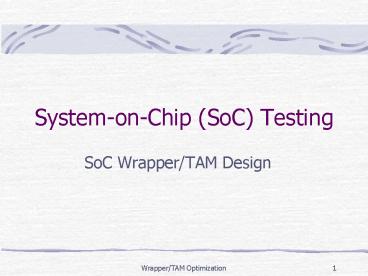SystemonChip SoC Testing - PowerPoint PPT Presentation
1 / 29
Title:
SystemonChip SoC Testing
Description:
One test Strategy: Use daisy chain to transport patterns to all cores at once, ... Test Bus Model for TAM Design: Cores on each TAM are sequentially tested ... – PowerPoint PPT presentation
Number of Views:43
Avg rating:3.0/5.0
Title: SystemonChip SoC Testing
1
System-on-Chip (SoC) Testing
- SoC Wrapper/TAM Design
2
Bibliography
- J. Aerts and E. J. Marinissen, "Scan chain
design for test time reduction in core-based
ICs," in Test Conference, 1998. Proceedings.,
International, 1998, pp. 448-457. - V. Iyengar, K. Chakrabarty, and E. J.
Marinissen, "Test Wrapper and TAM Co-Optimization
for SoC , " JETTA 18, pp. 211-228, March 2002. - S. Bahukudumbi and K. Chakrabarty, "Test-Length
and TAM Optimization for Wafer-Level Reduced
Pin-Count Testing of Core-Based SoCs,"
Computer-Aided Design of Integrated Circuits and
Systems, IEEE Transactions on, vol. 28, pp.
111-120, 2009. - M. Nahvi and A. Ivanov, "Indirect test
architecture for SoC testing," Computer-Aided
Design of Integrated Circuits and Systems, IEEE
Transactions on, vol. 23, pp. 1128-1142, 2004. - These papers are reviewed in this presentation.
3
Scan Chain Architectures
- J. Aerts and E. J. Marinissen, ITC 1998, pp.
448-457
4
Paper Summary
- Given
- pins of SoC available for external scan test
- scan patterns of each core
- scan FFs in each core
- the paper explores the pros and cons of three
possible scan-chain architectures for testing the
SoC with external source and sink.
5
Three Basic Scan Architectures
- Multiplexing Whole TAM width available to each
core, but one at a time. - Daisychain Long chains across multiple cores
simultaneously test multiple cores, bypassing
those for which the testing is completed. - Distribution Test many cores concurrently but by
dividing the TAM lines among them.
6
Multiplexing Architecture - 1
- Full TAM width available to each core exclusively
- DeMux/Mux at inputs and outputs are necessary to
connect TAM lines to core pins. - Each parallel scan chain requires two signals
scan-in and scan-out. Additionally, at least two
global signals are necessary to control
scan-enable and mux/demux
7
Multiplexing Architecture - 2
- scan chains available
- where, K pins available for scan test
- M number of control pins ( 2)
- Total test time, overlapping scan-in and
scan-out
8
Daisychain Architecture
- A 2-to-1 mux after each core selects either the
cores internal scan chain or the (buffered)
bypass - One test Strategy Use daisy chain to transport
patterns to all cores at once, until a core runs
out of patterns and is bypassed. - Other test strategies are also possible
9
Distribution Architecture
- Distribute the scan chains over the cores
- Each core gets assigned its own dedicated scan
chains - The number of scan chains must exceed the number
of cores.
10
Hybrid Architectures
- Test-Bus1 Combines multiplexing and
distribution. - TestRail2 Combines daisychain and distribution.
- P. Varma and S. Bhatia, ITC98, pp. 294-302.
- E. J. Marinissen et al., ITC98, pp. 284-293.
11
Test Wrapper and TAM Co-Optimization for SoC
- V. Iyengar, K. Chakrabarty, and E. J. Marinissen,
JETTA 18, March 2002, pp. 211-228
12
Paper Summary
- Simultaneous design of wrapper and TAM to
optimize the testing times for cores. - Algorithm improves on earlier methods of wrapper
design in reducing the TAM width required to
achieve optimum test time. - Another enumerative algorithm for TAM
optimization for small number of TAMs.
13
Example SoCs - 1 (from ISCAS Benchmarks)
14
Example SoCs 2(From Philips Research)
15
Unbalanced vs. Balanced Wrapper Chains
The time is minimized for balanced cores.
Unbalanced
Balanced
8 clocks/scan
14 clocks/scan
16
Wrapper Design Example without and with
Co-optimization
Assume Available TAM Width 4 4 inputs 2
outputs 4 scan chains 32, 8, 8, 8 long
Clearly, (b) utilizes TAM width better than (a)
17
Longest Wrapper Scan-in (Scan-out) vs. TAM Width
Problem Given the following internal scan chain
lengths, plot the longest wrapper scan length as
a function of TAM width k for k 1, 2, 3, 4, 5,
6. Given scan chain lengths 8, 8, 8, 8, 8, 10,
10, 10.
18
Example of a Philips p93791 core
Example Pareto-optimal point
- This core has
- 417 functional inputs
- 324 functional outputs
- 72 bidirectional I/Os
- 46 scan chains of lengths
- 7x500 bits
- 30x520 bits
- 9x521 bits
19
Two-Priority Wrapper Optimization Problem Formal
Statement
The paper provides an approximation algorithm
based on the Best Fit Decreasing (BFD) heuristic
to solve the problem.
20
Algorithm
21
Example Core and Result
22
Optimal Core Assignment to TAMs
- Test Bus Model for TAM Design Cores on each TAM
are sequentially tested
- Test Bus Model for TAM Design
Multiplexed Cores
Cores with Bypass
23
Problem Definition
- Minimize the system test time by assigning cores
to TAMs when the TAM widths are known
The problem can be shown to be computationally
difficult (NP-hard) but instances corresponding
to small number of cores can be solved using
integer linear programming (ILP)
24
An ILP Formulation
Assume Test Bus architecture B TAMs of fixed
widths w1, w2, , wB N Cores
Time needed to test all cores on TAM j
25
An ILP Formulation (Contd.)
- Objective Minimize
- subject to
26
Results for SoC from ISCAS Benchmarks -1
27
Generalizations - 1
- The paper goes on to solve the following
generalizations of the problems discussed so far
- Optimal Partitioning of TAM Widths
28
Generalizations - 2
- Wrapper/TAM Co-Optimization
29
Results for SoC from ISCAS Benchmarks -2































